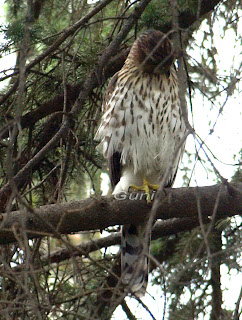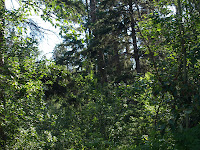 |
| Little Forest |
My new neighborhood is turning out to be a goldmine in terms of wildlife. After things finally settled down to a more typical life pace for me once again, I took a walk around the neighborhood to get to know where everything is. During my walk I discovered a patch of
forest
that was left standing when this neighborhood was developed only a couple of blocks from where I now live. It is about a block in length and about as wide. There is a lot of wildlife in that tiny little forest, from sparrows and squirrels, to wrens, cedar waxwings, and butterflies just to name a few I have seen so far. A nice touch for someone like me who loves to be surrounded by nature.
 |
| Forest Floor |
The first time I explored this patch of forest I kept hearing the voice of birds I had never heard before, but did not get a single glimpse of them despite circling the little forest three times. Their voices didn't remind me of
birdsong
however. They were different. More vocal. The only way to describe the impression I got from those voices, was one of very deliberate communication. Except that their voices are musical, consisting of the soft sounds birds are capable of, and at the same time carry a great distance.
 |
| First Juvenile Cooper's Hawk |
For several days after I could hear these birds calling to each other as I waited for the bus to go to work, when I got off the bus, walked to the store, and once even when I got ready for bed. From their loud calls I got the impression that these birds were large, and because their calls were coming from different directions I understood that they were not confining themselves to that little forest. But they obviously preferred it, because more often than not their voices could be heard coming from the direction of that tiny forest. Beautiful voices that cause me to feel more like I am in the middle of a forest rather than the city and so, since I have always been a curious person, naturally I eventually just had to follow them back to their source.
 |
| Juvenile Cooper's Hawk perched |
It took a couple of trips but I finally spotted the birds in question and got the most amazing surprise. These birds were juvenile hawks, Cooper's Hawks to be precise. At first I only saw only one, but as I stepped under the canopy of trees to get a closer look and make use of my camera, I got my second surprise. There were actually two hawks sitting on opposite sides of the same tree. The first one I saw had his back to me, showing the spotting which indicates that he is a juvenile, while the second one faced me, perched in the classic pose of a bird that is relatively relaxed. That is, she had one leg tucked close to her belly.
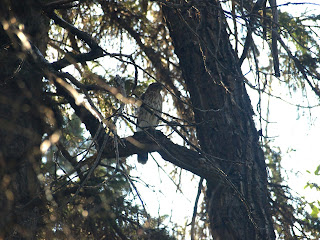 |
| Cooper's Hawk perched and close up |
As has happened once or twice before, I was so excited and happy, that I actually fumbled around with my camera, trying to change the setting so that I would get the best possible pictures and almost messed up completely. Once again I was not wearing my glasses and so the setting I used at first caused most of the pictures to be blue. Fortunately one of the Hawks stayed still in the tree long enough for me to get the setting right and also get a couple of decent pictures.
 |
| Juvenile Cooper's Hawk close up |
Cooper's Hawks, it turns out, do communicate very deliberately, usually with the female making reassuring calls to the male, and I suppose their young. They do communicate with visual displays but apparently due to the dense forest, which is their typical habitat, vocal communication is preferred. Obviously this little patch of forest that was left standing makes a perfect home for the Cooper's Hawk, to my great delight.
Here is what else I have learned about this hawk so far: Cooper's hawks are medium sized North American hawks, who make their home anywhere from southern Canada to northern Mexico. These hawks have begun inhabiting cities and towns, it seems, due to large populations or Rock Pigeons, since their primary diet consists of birds. Their life span is an average of twelve years, with the oldest known living Cooper's Hawk reaching 20 years.
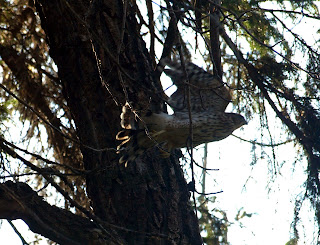 |
| Second Juvenile Cooper's hawk in flight |
Juvenile Cooper's Hawk spend time as "branchers" before learning to fly, perching in trees around the nest and still receiving food from the adults. The two juvenile Cooper's hawks I saw must be almost ready for independence, since I saw them fly short distances. However, I did see the parents fly in to protect them from a Goshawk that had arrived on the edge of the little forest just yesterday. Goshawks, who also prey primarily on birds, will sometimes hunt juvenile Cooper's hawks. This is when I heard the incredible range of vocalizations Cooper's Hawks are capable of, from alarm and distress, to fear and reassurance. An experience that I am unlikely to forget, which also caused me to learn something about the behavior of all of these hawks, both directly by sight and indirectly through my research.
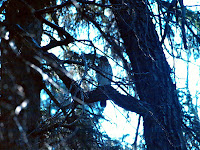 |
| Cooper's hawk in the distance |
I believe it was the female who flew in to protect the juveniles, as she seemed about the size of the Goshawk and I know from my research that the male cooper's is smaller than the female, although everything happened so fast that I can't be certain, and I wasn't fortunate enough to get pictures this time. The female Cooper's hawk can stand as tall as twenty inches in height. The juvenile Cooper's hawk, as you can see in my pictures, has golden yellow eyes, while the mature hawk has orange to red eyes. I have yet to see the adults up close, although there is still time before migration and I certainly intend to go back before the end of the season. You can recognize the Cooper's hawks by a long barred tail ending in white, an eyebrow marking similar to the Goshawk, and a black cap on the head which is brown on a juvenile. There is more information on this hawk at the following sites if, like me, you are interested:
http://www.hww.ca/hww2.asp?id=48
http://en.wikipedia.org/wiki/Cooper%27s_Hawk
http://swartzentrover.com/cotor/Photos/Hiking/Birds/BirdPages/CoopersHawk.htm
Note: the calls you hear on the link directly above is the alarm call of the Cooper's hawk
Here is a video:
http://www.encyclopedia.com/video/lERM_z105xo-juvenile-coopers-hawk.aspx
Enjoy,
Susan

 and a bird species that I have never seen before.
and a bird species that I have never seen before. this time, although I'm sure I will eventually. However, I did get some wonderful photos of the Cooper's Hawks residing in that little forest and I couldn't wait to share them.
this time, although I'm sure I will eventually. However, I did get some wonderful photos of the Cooper's Hawks residing in that little forest and I couldn't wait to share them. for quite some time. It was really quite amazing, although she did distance herself by hopping up to a higher elevation. Of the other two, one flew off almost immediately and the other, the one with his back to me, tolerated my presence only briefly.
for quite some time. It was really quite amazing, although she did distance herself by hopping up to a higher elevation. Of the other two, one flew off almost immediately and the other, the one with his back to me, tolerated my presence only briefly.




